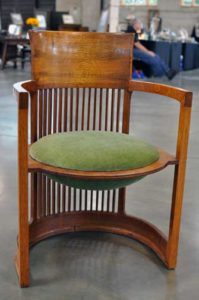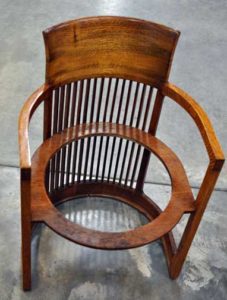Small Home Gazette, Winter 2017
A Missing Link?
The show and sale held every September at the Minnesota State Fairgrounds has evolved since its beginnings nearly 20 years ago. What has remained constant, and an aspect that I enjoy immensely, is the “show” part of the event.

As a breakthrough design, this chair was a smashing success. The barrel-curve of back slats and exposed, “Saturn” cushion are instantly associated with the designer, Frank Lloyd Wright. As a functional chair, this was a failure. Its lightweight, plywood construction and use of hide glue guaranteed that it would loosen up and become too fragile to use. The unknown question is where this chair fits within Wright’s career-long penchant for designing chairs.
Now known as the Twin Cities “20th Century Art and Design Show and Sale,” the weekend gathering continues to be a “must see” event for Gail and me. Every year there seems to be a piece or two that creates a buzz among the attendees; 2016 was no exception.
“Have you seen the Frank Lloyd Wright chair?” was a question that grabbed my attention last fall. I’m not a huge fan of his work—because so much of it put style ahead of long-lasting construction techniques—but to see and possibly touch an original Wright chair was too good an opportunity to pass up.
Brought to the show by Sidney Williams, an antiques dealer from Chicago, the Wright chair was situated among a respectable collection of Arts & Crafts era furniture, positioned on top of a table with large placards on either side—almost as if this example of Wright’s creative genius had been elevated, throne-like, above its “subjects.” There was no soundtrack of heraldic trumpets, but it would have been a nice touch!
Information on the placards built a case for authenticating the chair as an original Wright-designed chair. Williams’ point was not to justify a price tag (the chair wasn’t for sale) but to draw you down his personal Wright-themed rabbit hole.
Chair Odyssey
First, know that Wright designed over 200 distinctive, well-documented chairs during his long career. He was constantly tweaking their design to make improvements. These variations can make it hard to authenticate the date of an original.
Second, Wright’s personality and his up-and-down career led him to tirelessly defend the superiority of his work to dismissive architectural historians. Consequently, there’s a good collection of his drawings and papers available for study. But not every sketch was saved, nor was every variation recorded with a note or drawing.
Third, Wright’s lifestyle—multiple homes and wives—meant that he had a lot of possessions. It’s easy to imagine Wright bringing home a prototype chair that didn’t quite meet the client’s expectations. The chair might stay in place for years or be moved to another residence. No one I know keeps records of these kinds of changes.
 All of which is to say that if you’re on a quest to determine where and when a specific Wright-designed chair fits within his legacy, the pursuit is simultaneously exhilarating and frustrating. That’s been dealer Sidney Williams’ life since 1985 when he first acquired the chair from an auction in Milwaukee. Talking to him about his odyssey is like trying to sip from a fire hose. His words come fast and with force, and you hope that a few stick in your memory. Williams’ enthusiasm for pursuing rock-solid proof was obvious.
All of which is to say that if you’re on a quest to determine where and when a specific Wright-designed chair fits within his legacy, the pursuit is simultaneously exhilarating and frustrating. That’s been dealer Sidney Williams’ life since 1985 when he first acquired the chair from an auction in Milwaukee. Talking to him about his odyssey is like trying to sip from a fire hose. His words come fast and with force, and you hope that a few stick in your memory. Williams’ enthusiasm for pursuing rock-solid proof was obvious.
What is known and documented is that some of Wright’s earliest barrel chairs were designed for the D.D. Martin House in Buffalo, New York, in 1904. He updated the basic design in the late 1930s for use in two residences: Wingspread, near Racine, Wisconsin, and Fallingwater, near Pittsburgh, Pennsylvania. In between, he tinkered with the design for use in Taliesin East near Spring Green, Wisconsin, and one of his personal residences.
Williams’ theory is that his chair fits in between the 1904 and 1937 versions of the chair. He’s spent considerable effort building his case.
Proving the Link
The 1904 version was larger; had a darker finish; was made of solid oak; and had 15 back slats to form the barrel curve. The 1937 chair was smaller; lighter in color; was made with a five-layer oak veneer plywood; and had 17 back slats. Williams’ chair has characteristics of both.

Like sun rising out of a horizon, the oak veneers selected for the backrest of this chair mimic the sunburst pattern that designer Frank Lloyd Wright demanded from his craftsman. Attention to details such as these is a hallmark of Wright’s work.
Williams’ chair is closer to the 1930s version. It matches the smaller dimensions of the later version and is made with the characteristic plywood. The “sunburst” design of the wood grain on Williams’ chair shows an attention to detail that is a hallmark of Wright’s reputation for controlling how his furniture was constructed. But it has 15 slats and a finish that is more like the 1904 edition.
What makes a final determination difficult is the chair’s troubled condition. Williams’ description of how he found it at the sale reminded me of someone who has rescued an abused puppy.
“I was shocked by and feared the abused and tortured state,” Williams says. “Not only was its once novel “Saturn” seat ragged, moth eaten and ruinously stained, but its slight wood structure was crudely held together by bailing wire and multiple, added screwed-in steel braces.”
He reproduced the cushion; removed the added bracing; and carefully cleaned years of grime from the finish. The result is an object that demands you appreciate its beauty and style, while also lamenting the hard life it has endured.
It also has a distinct wiggle due to the use of notoriously imperfect hide glue as well its years of neglect. I discovered the wiggle when I moved the chair to take a better photograph.
Yes, you never know what you might see at the annual show and sale come September. And if you’re like me, you might just touch something great and then be thankful that it didn’t fall into a heap while you were touching it. Remember, ask permission first!
Resource
Frank Lloyd Wright: The Seat of Genius, Chairs: 1895–1955, a catalog for an exhibition held February 28 to April 25, 1997, at Eaton Fine Art, West Palm Beach, Florida.











